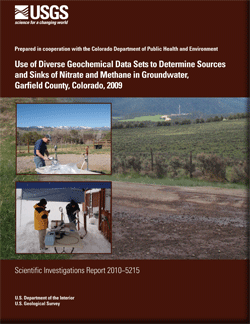Scientific Investigations Report 2010–5215

Previous water-quality assessments reported elevated concentrations of nitrate and methane in water from domestic wells screened in shallow zones of the Wasatch Formation, Garfield County, Colorado. In 2009, the U.S. Geological Survey, in cooperation with the Colorado Department of Public Health and Environment, analyzed samples collected from 26 domestic wells for a diverse set of geochemical tracers for the purpose of determining sources and sinks of nitrate and methane in groundwater from the Wasatch Formation. Nitrate concentrations ranged from less than 0.04 to 6.74 milligrams per liter as nitrogen (mg/L as N) and were significantly lower in water samples with dissolved-oxygen concentrations less than 0.5 mg/L than in samples with dissolved-oxygen concentrations greater than or equal to 0.5 mg/L. Chloride/bromide mass ratios and tracers of groundwater age (tritium, chlorofluorocarbons, and sulfur hexafluoride) indicate that septic-system effluent or animal waste was a source of nitrate in some young groundwater (less than 50 years), although other sources such as fertilizer also may have contributed nitrate to the groundwater. Nitrate and nitrogen gas (N2) concentrations indicate that denitrification was the primary sink for nitrate in anoxic groundwater, removing 99 percent of the original nitrate content in some samples that had nitrate concentrations greater than 10 mg/L as N at the time of recharge. Methane concentrations ranged from less than 0.0005 to 32.5 mg/L and were significantly higher in water samples with dissolved-oxygen concentrations less than 0.5 mg/L than in samples with dissolved-oxygen concentrations greater than or equal to 0.5 mg/L. High methane concentrations (greater than 1 mg/L) in some samples were biogenic in origin and appeared to be derived from a relatively deep source on the basis of helium concentrations and isotopic data. One such sample had water-isotopic and major-ion compositions similar to that of produced water from the underlying Mesaverde Group, which was the primary natural-gas producing interval in the study area. Methane in the Mesaverde Group was largely thermogenic in origin so biogenic methane in the sample probably was derived from deeper zones in the Wasatch Formation. The primary methane sink in the aquifer appeared to be methane oxidation on the basis of dissolved-oxygen and methane concentrations and methane isotopic data. The diverse data sets used in this study enhance previous water-quality assessments by providing new and more complete insights into the sources and sinks of nitrate and methane in groundwater. Field measurements of dissolved oxygen in groundwater were useful indicators of the Wasatch Formation’s vulnerability to nitrate and methane contamination or enrichment. Results from this study also provide new evidence for the movement of water, ions, and gases into the shallow Wasatch Formation from sources such as the Mesaverde Group and deeper Wasatch Formation. |
First posted January 27, 2011 For additional information contact: This report is presented in Portable Document Format (PDF); the latest version of Adobe Reader or similar software is required to view it. Download the latest version of Adobe Reader, free of charge. |
McMahon, P.B., Thomas, J.C., and Hunt, A.G., 2011, Use of diverse geochemical data sets to determine sources and sinks of nitrate and methane in groundwater, Garfield County, Colorado, 2009: U.S. Geological Survey Scientific Investigations Report 2010–5215, 40 p.
Abstract
Introduction
Purpose and Scope
Description of Study Area
Study Methods
Sample Collection
Sample Analysis
Groundwater Age
Geochemical Data Sets
Distributions of Oxygen, Nitrate, and Methane in Groundwater
Major-Ion Chemistry
Groundwater Mixing
Stable Isotopes of Water
Apparent Groundwater Ages
Chloride/Bromide Mass Ratios
Summary of Mixing Results
Sources and Sinks of Nitrate in Groundwater
Sources and Sinks of Methane in Groundwater
Hydrocarbon Molecular and Isotopic Compositions
Helium Concentrations and Isotopes
Methane Transport
Summary
Acknowledgments
References Cited